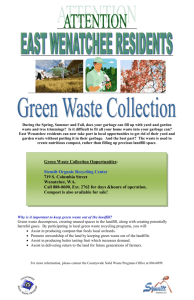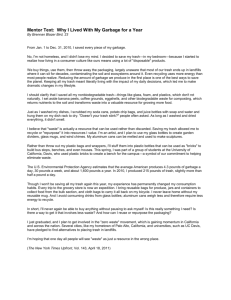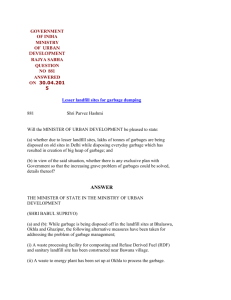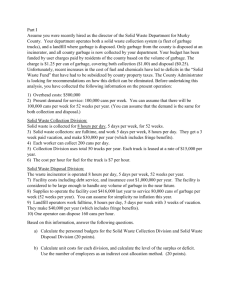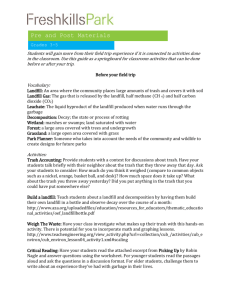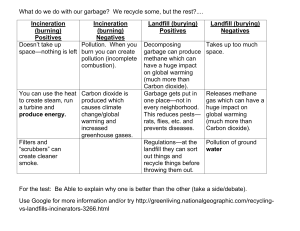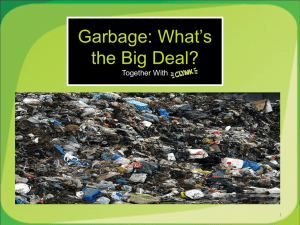WHERE DOES THE GARBAGE GO
advertisement
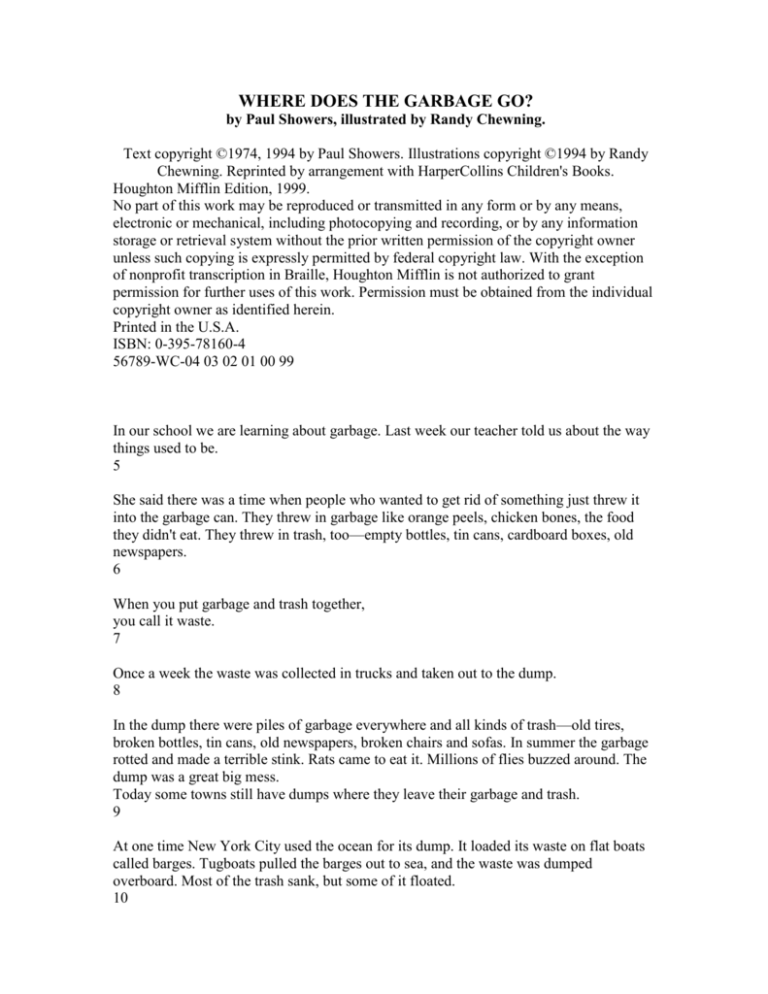
WHERE DOES THE GARBAGE GO? by Paul Showers, illustrated by Randy Chewning. Text copyright ©1974, 1994 by Paul Showers. Illustrations copyright ©1994 by Randy Chewning. Reprinted by arrangement with HarperCollins Children's Books. Houghton Mifflin Edition, 1999. No part of this work may be reproduced or transmitted in any form or by any means, electronic or mechanical, including photocopying and recording, or by any information storage or retrieval system without the prior written permission of the copyright owner unless such copying is expressly permitted by federal copyright law. With the exception of nonprofit transcription in Braille, Houghton Mifflin is not authorized to grant permission for further uses of this work. Permission must be obtained from the individual copyright owner as identified herein. Printed in the U.S.A. ISBN: 0-395-78160-4 56789-WC-04 03 02 01 00 99 In our school we are learning about garbage. Last week our teacher told us about the way things used to be. 5 She said there was a time when people who wanted to get rid of something just threw it into the garbage can. They threw in garbage like orange peels, chicken bones, the food they didn't eat. They threw in trash, too—empty bottles, tin cans, cardboard boxes, old newspapers. 6 When you put garbage and trash together, you call it waste. 7 Once a week the waste was collected in trucks and taken out to the dump. 8 In the dump there were piles of garbage everywhere and all kinds of trash—old tires, broken bottles, tin cans, old newspapers, broken chairs and sofas. In summer the garbage rotted and made a terrible stink. Rats came to eat it. Millions of flies buzzed around. The dump was a great big mess. Today some towns still have dumps where they leave their garbage and trash. 9 At one time New York City used the ocean for its dump. It loaded its waste on flat boats called barges. Tugboats pulled the barges out to sea, and the waste was dumped overboard. Most of the trash sank, but some of it floated. 10 Often it floated right back to the beaches where people were swimming. Ugh! Yeccch! 11 New York City doesn't throw its waste in the ocean anymore. It has a special kind of dump called a landfill. Other cities have landfills, too. Our town has one, and our class went out and looked at it. A landfill is a busy place. 12 Trucks bring loads of waste from the city and dump it in big piles. Bulldozers with scrapers spread out the waste. Compactors with spikes on their wheels move back and forth over it. The waste is all mashed and piled. 13 After that, trucks bring loads of soil. The bulldozers and compactors spread the soil over the waste. The soil covers up everything. It keeps out the rats and flies. Then the landfill is ready for more waste. Then comes more soil to cover it up—then more waste and more soil, layer after layer. A landfill keeps piling up. It gets to be a little mountain. 14 When the last layer of soil is spread on top of a landfill, grass and trees are planted on it. The landfill becomes a park or a playground. Then the city has to start a new landfill. Waste never stops piling up. 16 Some cities try to get rid of their waste by burning it. They build big furnaces called incinerators and burn garbage and trash in them. The heat is used to warm stores and offices. It is also used to make electricity. 18 How an incinerator works trucks bring garbage garbage is fed to a furnace furnace burns garbage in about 30 minutes gases from the burning garbage must be carefully cleaned and filtered cleaned gases are released 18 But incinerators don't really get rid of everything. They simply turn the waste into ashes, and the ashes have to go to a landfill. Sometimes those ashes are toxic or harmful. And sometimes the smoke from the incinerator pollutes the air with harmful gases. 19 Today cities are having a hard time finding places for new landfills. Waste keeps piling up. People keep throwing things away. They throw away too many things. Some of the things they throw away could be used over again. ---Each person in the U.S. creates about four pounds of trash every day. 20 Many cities are now trying something that is new for them. It is called recycling. Recycling means making trash into something new instead of throwing it away. Almost half of the trash we throw away could be recycled. Look for this symbol on glass, metal, and plastic containers that can be recycled. 21 Our city is recycling. We still put garbage in the garbage can—orange peels, chicken bones, the food we don't eat. But we keep empty glass bottles in a separate box. Aluminum cans and foil are kept separate, too. When we put the cans and bottles at the curb, we pile old newspapers beside them. We flatten our cardboard boxes and pile them next to the newspapers. 22 When the garbage truck comes, it picks up only the garbage and takes it out to the landfill. Other trucks come for the bottles and cans and newspapers. Those things don't go to the landfill anymore. Our city sells them to factories and mills for recycling. 23 Paper mills chop up old newspapers and turn them into new paper. 24 Aluminum factories take aluminum cans and foil and melt them to make new cans and rolls of foil. 25 Glass bottles are ground up and melted to make new glass bottles and jars. other glass bottles are crushed some bottles are sterilized and reused glass is melted in a furnace blown-in air cools glass gobs of molten glass are poured into molds 26 Even plastic can be recycled. Plastic factories chop it up and turn it into things like flowerpots and park benches. bits are washed and dried plastic is melted and poured into a mold 27 Our teacher says recycling is a good start, but we must do more. We must stop making so much waste. We must stop throwing so many things away. We need to find ways to use things over and over again. 29 That's what we have done at home. We used to bring our groceries home in paper and plastic bags. When we emptied the bags, we threw them in the garbage can. When we did that, we were just making more waste to pile up in the landfill. We have stopped doing that. Now we use string bags. They hang on the kitchen doorknob. When we go to the supermarket, we take our string bags and put our groceries in them. 30 We never throw away our string bags. They are strong and hold a lot of groceries. We use them over and over again. 32

